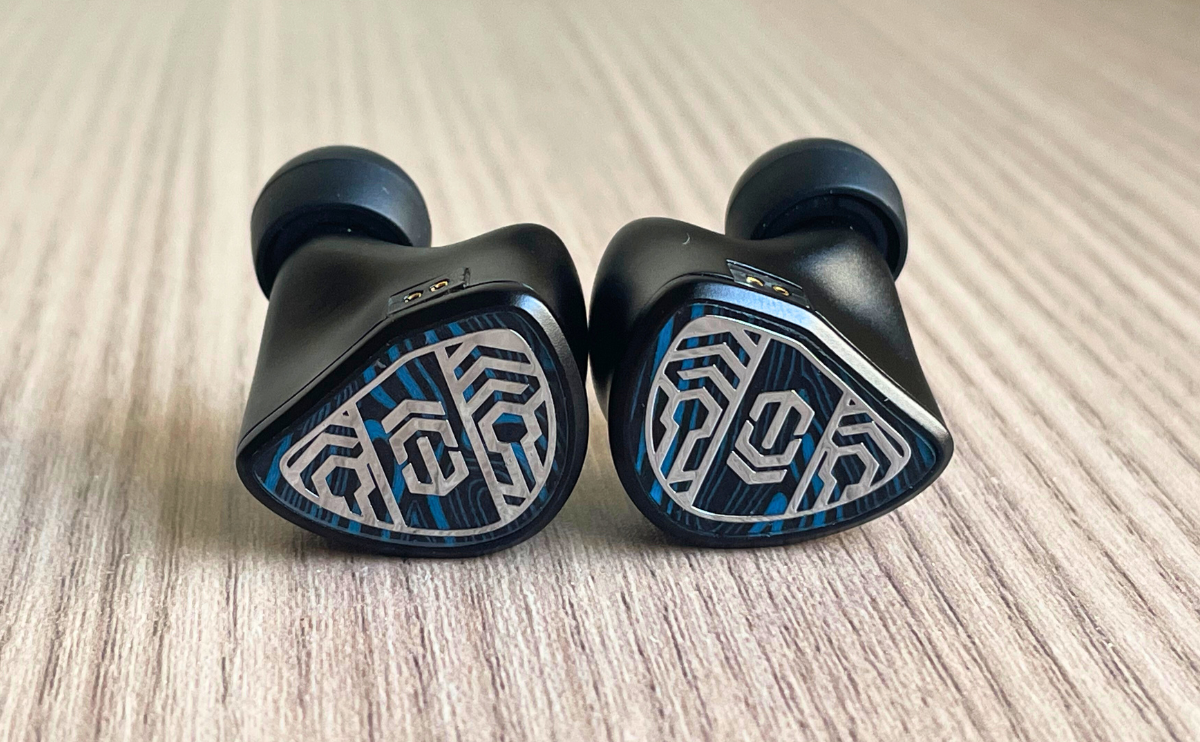I. Introduction
Ice Lab, a fresh brand from Hong Kong, has recently caught my attention thanks to my friend Mr. Pulkit from Gadget Generations. The Prismatica IEM I’m reviewing today is his unit, which he kindly lent me for testing. Rest assured, all opinions in this review are entirely my own and are in no way influenced by Ice Lab or Mr. Pulkit.
The Prismatica IEM comes equipped with 5 balanced armature (BA) drivers and a 3-way PTBC crossover. Priced globally at $890, it’s marketed as a premium IEM. Let’s dive deep into this review and find out whether the Ice Lab Prismatica is worth the hype.

II. Design and Build Quality
The design of the Ice Lab Prismatica is both elegant and eye-catching. The faceplate showcases a beautiful blend of blue and black tones, with the logo crafted from metal, adding a touch of sophistication. The shell itself is constructed from metal, giving it a premium and sturdy feel. Overall, it exudes a sense of durability while maintaining a classic and refined aesthetic.

III. Comfort and Fit
For my testing, I paired the Prismatica IEM with Divinus Velvet Eartips, which provided an excellent fit. The ergonomic design of the IEM shell makes it feel almost like a semi-custom fit, offering top-tier comfort. The isolation is superb, and I experienced no discomfort or fitting issues with my medium-sized ears, making these a great choice for long listening sessions.

IV. Sound Quality
Before diving into the sound analysis, here’s my setup: I used a HiBy R8 II digital audio player with the stock 4.4mm cable and Divinus Velvet Eartips. I expected the Prismatica to sound like a typical BA IEM, but the moment I pressed play, I was blown away by the powerful sub-bass performance. It has a rich, immersive quality, something I don’t often experience with all-BA IEMs, with the exception of models from Symphonium and 64 Audio.
Bass
Many BA driver-based IEMs are often criticized for lacking sub-bass, but the Ice Lab Prismatica delivers powerful and rumbling bass that rivals dynamic drivers. The sub-bass feels deep and impactful, almost dynamic in nature. In fact, after the Symphonium Audio Meteor & Crimson, the Prismatica stands out as another all-BA IEM that can deliver such robust bass. The sub-bass decay is balanced—neither too fast nor too slow—offering a full, reverberating bass experience. The mid-bass is also slightly forward, complementing the sub-bass perfectly.
It’s clear the Ice Lab team knows how to extract impressive bass from balanced armature drivers.
Midrange
The midrange on the Prismatica is smooth, detailed, and realistic. Both male and female vocals are handled effortlessly, with impressive clarity between vocals and instruments. It feels as though each minute detail is playing around you. I particularly enjoyed the texture of male vocals on this IEM. The midrange is neither in-your-face nor too distant, achieving a perfect balance. This showcases Ice Lab’s expertise in tuning their IEMs for an enjoyable listening experience.
Treble
If the bass and midrange impressed me, the treble was the cherry on top. The Prismatica delivers clean, detailed treble with excellent extension. On rare occasions, I noticed a slight metallic timbre typical of some BA drivers, but it’s never overwhelming. The treble is a perfect blend of detail and musicality, making it an enjoyable listen without any harshness.
Soundstage & Imaging
The soundstage is wide and holographic, creating an immersive listening experience. Imaging is precise, though I feel it could be improved slightly to match the overall excellence of the IEM.

V. Value and Competition
At $890, the Ice Lab Prismatica competes with other high-end IEMs. I compared it with the Aful Cantor, which is similarly priced and also uses BA drivers—14 in the case of the Cantor compared to the 5 in the Prismatica.
Ice Lab Prismatica vs. Aful Cantor
Both IEMs have premium builds, though the Prismatica uses a metal shell, while the Aful Cantor opts for acrylic. Personally, I find the Aful’s faceplate more visually appealing, but the Ice Lab Prismatica feels more durable due to its metal construction. In terms of size, the Cantor is slightly more compact than the Prismatica.
There are two major differences between these IEMs:
- Bass: The Cantor's bass is more polite and faster in decay compared to the Prismatica. The Prismatica’s bass feels fuller and more satisfying to my preferences. While the Cantor offers a slightly more textured bass, the Prismatica’s low-end is more impactful.
- Detail and Clarity: The Aful Cantor is more detailed and crisp, almost like the Prismatica on steroids. It delivers a cleaner and clearer sound, with better imaging precision.
In terms of soundstage, both IEMs are similar, but the Cantor edges ahead in imaging precision. The Prismatica has a warmer overall sound signature, whereas the Cantor offers a slightly thinner but more detailed presentation.
Ultimately, both IEMs are excellent and unique in their own ways, and the choice depends on your personal sound preferences.

VI. Pros and Cons
| Pros | Cons |
|---|---|
| Powerful, rumbling bass | Shell size might be an issue for small ears |
| Balanced, smooth midrange | Imaging could be slightly more precise |
| Detailed, musical treble | |
| Wide, holographic soundstage | |
| Non-offensive tuning | |
| Rich, immersive sound |
VII. Conclusion
If you’ve made it this far, you can probably guess that I highly recommend the Ice Lab Prismatica. It’s an IEM that’s worth considering, especially if you’re in the market for a sub-bass-heavy, all-BA IEM. I thoroughly enjoyed my time with it and am seriously considering adding it to The Audio Store’s collection so more of you can experience it firsthand before making a purchase.
A special thanks to Mr. Pulkit for introducing me to this hidden gem and allowing me to review it. If you have any questions, feel free to ask in the comments. Don’t forget to follow our WhatsApp Channel, and check out our frequency graph database here (link).
Thank you for reading, and see you in the next one!




















